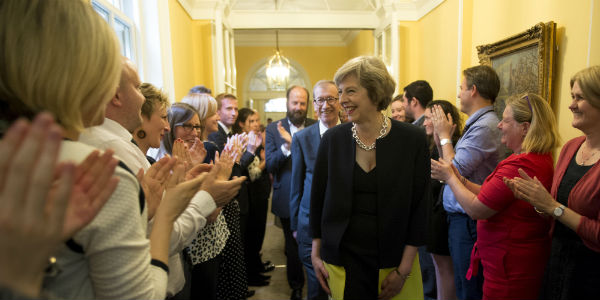May cuts Whitehall spads but keeps her own as she consolidates power in No 10
When she came to power, Theresa May announced she would cap the salaries of special advisers (spads) – leading to warnings that it would be difficult to recruit good candidates. Their numbers have fallen from 95 to 83 since the Cameron era, but almost all have gone from departments rather than No 10. Ben Yong and Harmish Mehta argue that while spads are not overly concerned about their pay, May’s priority is consolidating power in the fractious Brexit era rather than technocratic measures of effectiveness.

Behind the scenes… Theresa May, followed by her husband and one of her chiefs of staff, Nick Timothy, is clapped by staff as she enters No 10 for the first time as PM. Photo: No 10 via a CC-BY-NC-ND 2.0 licence
When Theresa May first became Prime Minister there were a number of reports (including in The Times, The Telegraph and Civil Service World) that she had insisted on a cap on the salaries of special advisers (spads) – which in effect would limit both the number and quality of spads appointed. This cap, the reports said, would deter good people from entering government. How true are these claims?
Just before Christmas, the government made its annual data release, setting out the number of spads and how they are distributed across government. There are now 83 spads in government; down from 95 under Cameron’s 2015 government, according to the data release. The centre (broadly defined as No. 10 and the Cabinet Office) has ‘lost’ just one spad; the key Whitehall departments have lost eleven (most significantly from the merging of BIS and DECC into BEIS; and in the Treasury). So there has been a drop in numbers, but this has fallen mostly on departments, not the centre. There has been the usual grumble about salaries and cost, but that is standard fare.
The bigger question is what all this says about May’s government, and more generally, British government. In popular parlance, spads are regarded as a waste of money and at worst, a pernicious breed of quasi-politicians. Within Westminster and Whitehall, however, they have long been accepted as part of British government. Spads are people the minister can completely trust, in a lonely and difficult role; they provide political advice of a kind that career civil servants often cannot; they can help coordinate government. It is this latter view of spads which informs some criticisms of May’s policy on spads (see The Spectator and The Telegraph). Limiting the number of spads and the kind of spads via a salary cap means limiting government effectiveness.
Maybe. But salaries are not the main attraction of being a spad. There are far more important ‘pull’ factors – primarily, the excitement of potentially being able to shape government policy; and the non-monetary dividends that follow from the unparalleled experience of being in government (networks, credentials and reputation – and now, it seems, peerages). The so-called ‘salary cap’ is unlikely to deter qualified candidates.
It also depends on what government effectiveness means – and to whom. There are various technocratic measures for effectiveness (‘evidence based policy’ and so on) but there are also political measures which are just as important – in particular, unified and cohesive government.
At the beginning of the coalition David Cameron was said to have asked the newly appointed cohort of spads, ‘Who do you work for?’, and then answered his own question: ‘You work for me.’ To underline the point, the Ministerial Code was changed: spads were appointed to serve the government as a whole and not just their appointing minister. At the time this was interpreted as a contingent response to coalition government – ensuring a consistent government line in the face of a government composed of two very different political parties.
The anecdote, and the change to the Ministerial Code (which remains in the latest version), point to a fundamental problem in British government. Here is Jonathan Powell in his book The New Machiavelli:
The British system of government is traditionally a feudal system of barons (Cabinet ministers) who have armies and funds (civil servants and budgets), who pay fealty to their liege but really get on with whatever they want to do. There is very little that the prime minister can do to make the government consistent or coherent. The only weapon he has in his armoury, a very blunt one, is hiring and firing people.
In fact, successive PMs have been wary of providing too many spads to any one minister (other than themselves, of course) for fear that instead of ensuring better, more effective government, spads would instead increase conflict within government – they would undermine the deep political necessity for unity. Harold Wilson, for instance, set a cap of two spads per minister to ensure Tony Benn had limited means to cause trouble (he did anyway). During Tony Blair’s time in government, there were a number of notorious briefings by Blairite and Brownite advisers against each other. Spads are, for the most part, personal appointments. Their primary loyalty is to their minister, regardless of the paper verities of the Ministerial Code.
At the same time, PMs have usually been very happy to bolster their own spad numbers. Spads at the centre are centripetal rather than centrifugal – joining up policy, coordinating, and ensuring everyone remains on message. Thus the number of spads at the centre has broadly risen over time (Blair, for instance, had around 30 in his heyday; Brown 27). Under the Coalition the number of spads at the centre reached 28 for the Conservatives (49 overall if we include Nick Clegg’s spads); in 2015 David Cameron in fact raised the number of spads at the centre to 34.
Theresa May reigns over a particularly fractious government, split between Brexiteers and Remainers. This cohort of spads mirrors that to some extent. It is a ‘mid-term’ cohort: a mixture of old faces and new arrivals. Just over 50 per cent were spads under Cameron (either in 2010–15 or 2015–16); the rest are new. Indeed, half of all spads (16 of 33) at the centre are new to government. There is unlikely to be a strong sense of shared purpose. Given the general institutional weakness of the Prime Minister, one means for May to ensure unity was to limit her colleagues’ capacity to act against the government line. That meant reducing the number of spads in departments, whatever their purported benefits, while maintaining her own relatively meagre resources. Technocratic measures of effectiveness give way to more fundamental political concerns.
This post represents the views of the authors and not those of Democratic Audit. It was first published at the Constitution Unit blog.
 Dr Ben Yong (left) is a lecturer in law at the University of Hull and an honorary staff member at the Constitution Unit. He is the co-author, with Robert Hazell, of Special Advisers: Who they are, what they do and why they matter (Hart, 2014).
Dr Ben Yong (left) is a lecturer in law at the University of Hull and an honorary staff member at the Constitution Unit. He is the co-author, with Robert Hazell, of Special Advisers: Who they are, what they do and why they matter (Hart, 2014).
Harmish Mehta is a Research Volunteer at the Constitution Unit. He holds an LLB in Law from the London School of Economics.





 Democratic Audit's core funding is provided by the Joseph Rowntree Charitable Trust. Additional funding is provided by the London School of Economics.
Democratic Audit's core funding is provided by the Joseph Rowntree Charitable Trust. Additional funding is provided by the London School of Economics.
[…] That would certainly not be ideal" Cabinet minister Mr Cameron has pledged to renegotiate Britain’s relationship with Brussels before holding a referendum before the end of 2017. He has said that if his renegotiation is successful, he will campaign for Britain to remain in Europe. Downing Street insists that no decision has yet been taken on whether collective responsibility will apply ahead of the referendum. However, Mr Cameron has made clear that he expects all of his Cabinet members to back the renegotiation. May cuts Whitehall spads but keeps her own as she consolidates power in No 10. […]